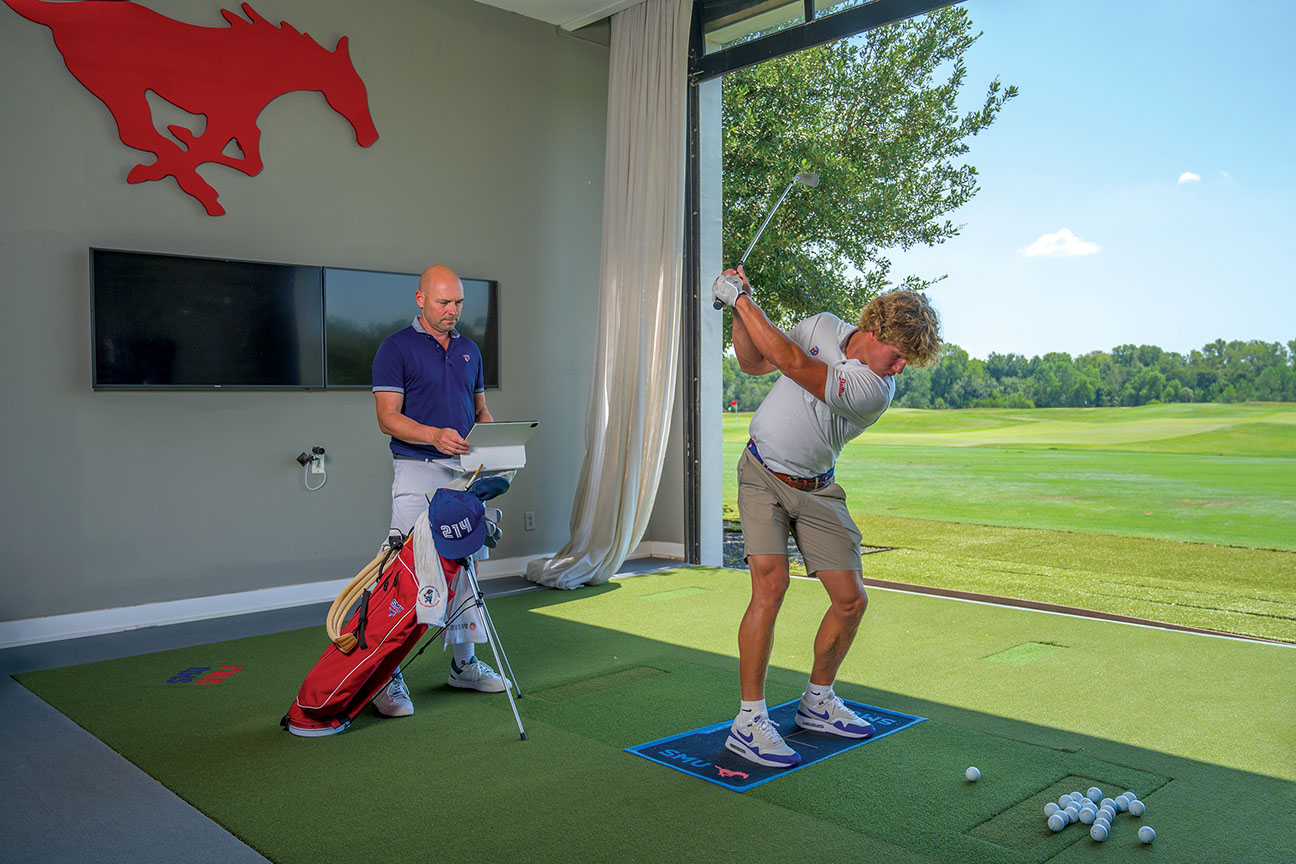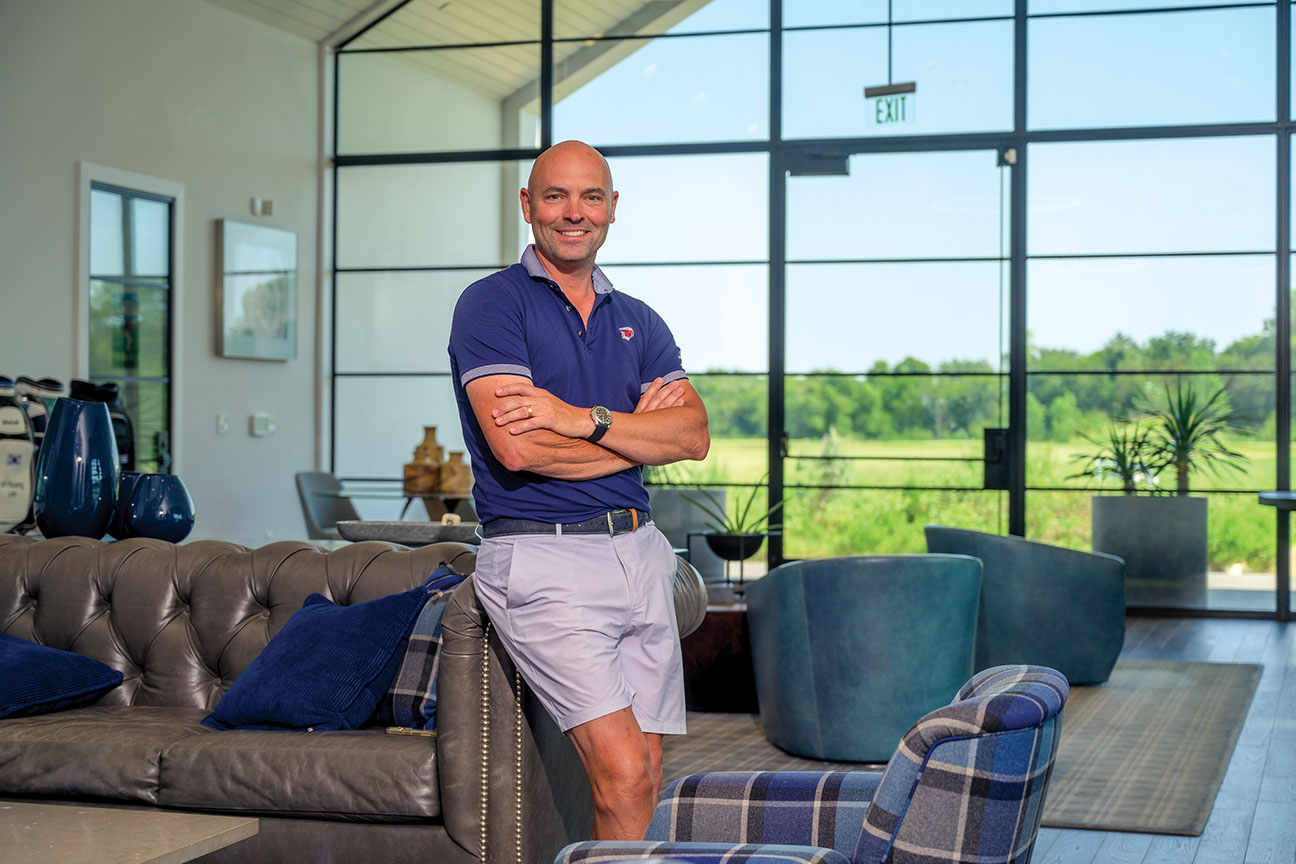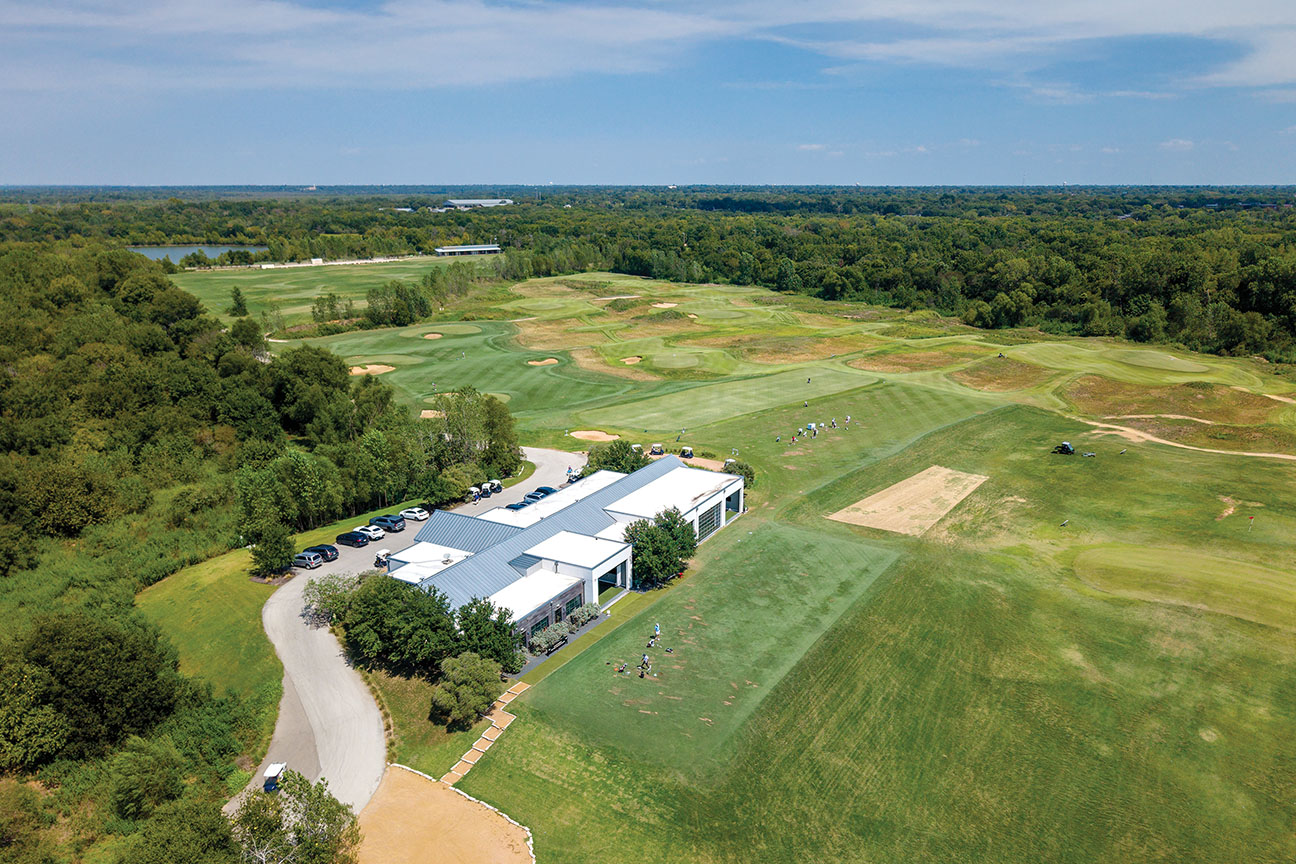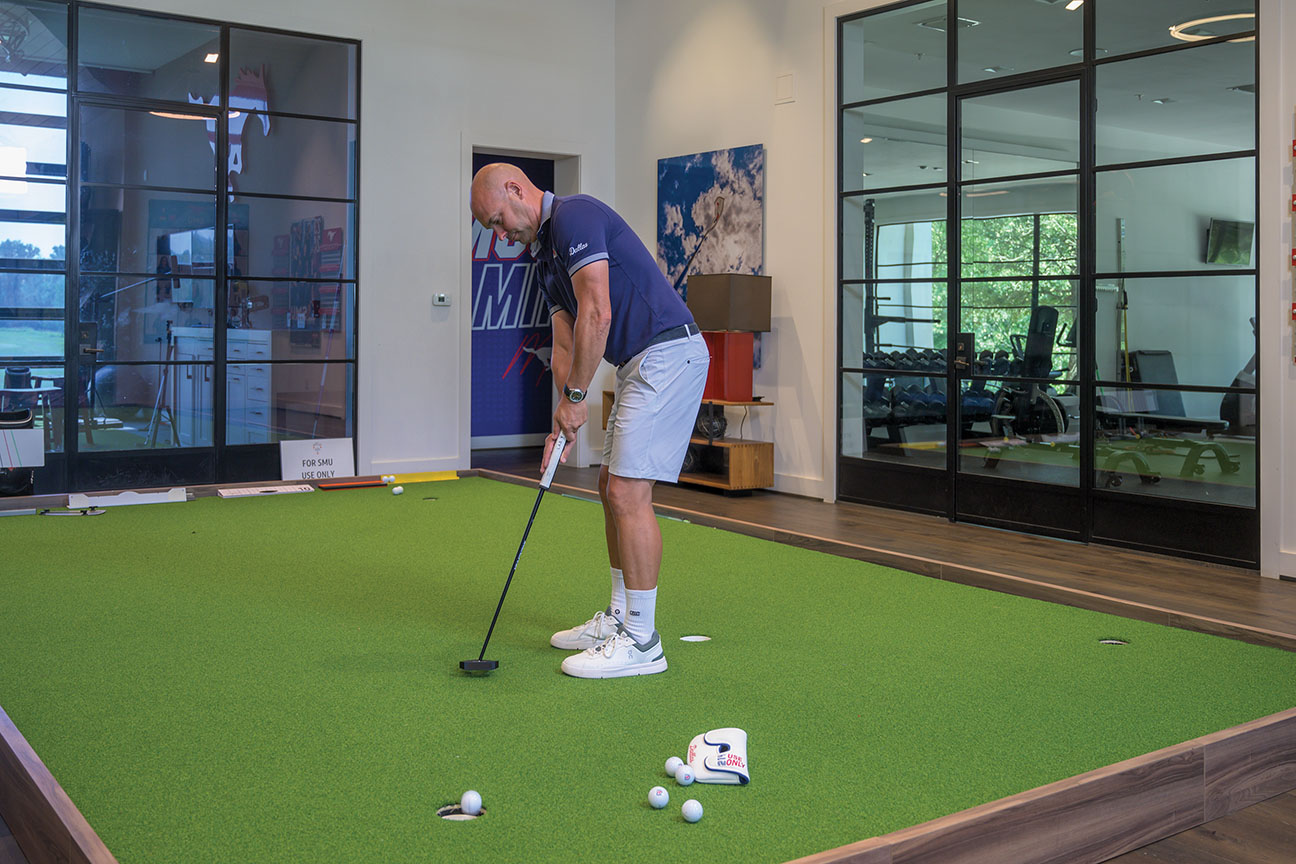Chris Parra’s career in golf has taken plenty of twists and turns along the way. From evenings working on his game at Las Colinas Country Club and TPC Las Colinas (now The Nelson Golf & Sports Club), to beginning his collegiate career playing for the legendary John Fields at the University of New Mexico, Parra had plenty of game. After a short stint at UNM, Parra felt the need to return home to tee it up for his hometown SMU Mustangs. Following his time at SMU, the Irving native turned professional, playing for 14 years, mainly on what is now the Korn Ferry Tour. A career highlight came in 2006 at the Byron Nelson, where he made the weekend and finished 72nd on the course he spent evenings learning to play the game.

After a hip injury, Parra was forced to reevaluate his career path. During a taxing rehabilitation for the injury, Parra received a call from then-SMU Head Coach Jason Enloe, who invited his friend and former teammate to join the staff. Parra accepted the role. In 2018, Enloe’s wife, Katie, passed away, and the following year he chose to step away from coaching to focus on his family. At that point, Parra was elevated to interim head coach. On April 16, 2020, after guiding the team through the 2019-20 season, he was officially named the Jerry Pittman Head Men’s Golf Coach.

Now, in his seventh season, Parra runs the ship for a program that has produced Tour talent like Payne Stewart, Hank Kuehne, Colt Knost, Kelly Kraft, Austin Smotherman, Noah Goodwin, and Bryson DeChambeau.
Parra and his team hold court at the Payne Stewart SMU Golf Training Center, a state-of-the-art facility at Trinity Forest Golf Club in south Dallas. The Mustangs enjoy full access to the course along with a dedicated practice area on the north end of Trinity’s massive property.
AVIDGOLFER Magazine spoke with Parra about his career, his voyage to leading the Mustangs program and the legacy he wants to leave with the program that has given him so much.
Let’s chat about your golf story. How did you get started playing and how did that journey help lead you to SMU?
I grew up at Las Colinas Country Club near the 15th green. My parents were members there and also across the street at The Four Seasons. I guess I was just kind of that country club kid. I played tennis, I played golf and I would swim during lunch. My grandfather also lived on the front nine at Las Colinas. So, between the two houses, I guess that’s how I got started. I would just go out at night and chip and putt with my dad.
AG: At what point did you think it might be something you wanted to pursue at a higher level?
I would say around 13 or 14 when I actually started playing some of the Northern Texas PGA events. That’s kind of all there was. The AJGA was really small, so I didn’t play much AJGA until my senior year. And then John Fields, when he was still at University of New Mexico, recruited me.
When did you come back to SMU?
I went up to Albuquerque and I loved John, loved the guys, but I just didn’t like Albuquerque like I thought I would. I think growing up in Dallas it was just a little too slow for me. I had the opportunity to transfer back to SMU, which is where I’d always wanted to go. So, I made my way back to Dallas.

What lead you from being a player at SMU to coming back as a coach?
I met a lot of great guys playing at SMU. I even learned a lot about coaching inadvertently. I left school in 1999 to turn pro and played for 14 years professionally. Then I tore my labrum in my left hip. There was lots of rehab and I was going to have to start completely over on the Korn Ferry and go all the way through Q-School. One of my best friends that I played one year at SMU with, Jason Enloe, had just taken over as head coach in 2014. I was literally sitting on a rehab table when he called me and asked me if I’d coach. I was his assistant until October of 2019 when he stepped away because of his wife passing away. With two young daughters, he chose to focus on his family and stepped away, so they made me interim head coach.
Shortly after you took over as head coach, you had to go through COVID and all that. What kind of challenge did that present as you were trying to get your feet under you, like as a new head coach and then all of a sudden that happens.
COVID hit everybody hard. When the city started shutting down, we knew something might happen. We had just won back back-to-back tournaments in the fall. We were number two in the country and we were ready for some big things. We were playing and competing with the big boys, the big state schools and getting ready to make a run. And I get a call from my sport oversight and he said we needed to get the team together for an announcement. We were right in the middle of qualifying and we were pulling the team off the golf course. It was crazy.
How did it impact recruiting?
We knew we were going to have to start doing things virtually. So, we spent a few hours just getting drone footage of the facilities and golf course so we would have it to send to recruits. We were able to send it to our potential kids and built a relationship that way. It took off from there. Word of mouth about this place, Trinity Forest, and our facility, and what Jonas Woods has done down here is pretty incredible for the SMU golf family.
You mentioned the facilities. It’s state of the art. How much of an advantage is that for you when it comes to recruiting?
It’s been great. The kids that we can get here that want to come see it, that haven’t heard about it, they fall in love immediately. You pull in the gate and there are 250 members. That means we can play at 8 o’clock in the morning on a Thursday or we can play at 10 o’clock on a Saturday. The access we have to the course is incredible. And the facilities … my goodness I wish I had this as a player. Jordan Spieth plays and practices here. Tom Kim is here. Noah Goodwin, Mac Meissner, Harry Higgs, Austin Smotherman … all former SMU players all practice here. I mean, all these guys are playing out because it’s one of the best facilities in the country.
How do you see it impact their play?
You can see their development across the board. Their stroke averages are getting better every year, whether it’s our number one player or number 10 player, they’re all getting better. And it’s because of what we have here to help them improve.
Speaking of recruiting, how much is that involved with NIL and all that stuff over the last few years?
The whole ruling on roster cuts is fine and we’ll all deal with that. But, you know, from a small private school where tuition is $90,000 a year, and then you have a state school that can give full academic rides to a kid, it has become very challenging. Obviously, we all know that the major bulk of the revenue share is going to go to football programs or basketball men’s and women’s or baseball if they have it. Olympic sports are, it is what it is, right? We drive no revenue, no matter if you’re number one in the country. We are on Golf Channel some, but, you know, ideally, a school like SMU is going to be known if the football program is really good, or the basketball is succeeding At the end of the day, I’m okay with it because Corey [Donnell] and I are going to build relationships, and help these kids grow as people, and to me, if you find the right kids, that’s more valuable than a $50,000 check that a kid’s taking. We’re hearing about golf programs that may be paying $500,000 to a $1 million for their team. To me, that’s not coaching, you’re not building a relationship, you’re just buying your team. You have no investment in that player. Something that I think I can hang my hat on is these kids almost become our kids. In the ten years I’ve been coaching, we’ve only had two kids leave the city of Dallas once they graduate. I don’t think that happens in any other school in the country, no matter how prolific it is.

How do you kind of maintain that dance between being a coach and also trying to be a player’s coach where you’re, friendly with the guys? And like, how does that balance work?
You know, I think one of my things is I tell all my guys as I’m recruiting them is if you really want to make it, I’m going to be tough on you at times … but it’s an arm around you tough, because I care about the feelings. I know how I was treated in school and it was definitely the opposite. I think it’s big, especially nowadays with kids. You need to put an arm around them sometimes, when you’re going to be tough on them. Especially if they want to make it because the world doesn’t get easier. With PGA-U, these kids get a taste of what your whole life could be like. Whether they’re trying to get in an elevated event like Harry Higgs, Mac [Meissner] and Austin [Smotherman] or whether you’re just trying to keep your card like some players. I was on and off the Korn Ferry and it doesn’t get any easier.
You know, you mentioned some of these guys like Harry, Mac, Austin and even Bryson. How great has it been to see them continue to develop as they have embarked on their professional journeys?
Coming from a small school like SMU, like, those guys trusted the process and that’s a thing we reinforce to the players. It’s a process. You don’t have to go to one of these big powerhouse schools to be a contender. Having Bryson take us out to Dallas National and having Harry [Higgs] and Noah [Goodwin] and Mac [Meissner] and Austin [Smotherman] and even guys like Ollie Osborne, who almost won the U.S. Amateur. I mean, you would have been our fifth or sixth U.S. Amateur winner since Hank Kuehne. For a small school, and I will call it a small school, it’s pretty amazing. The family dynamic is amazing to have those guys around consistently.
I know you weren’t Bryson’s head coach, but you were here as an assistant when he was on the team. What do you make of this 180 he’s made with his personality and image over the last few years?
I wouldn’t say Bryson’s like changed and become this whole new image. He was funny back then. We would land in Las Vegas for the Southern Highlands event, and he and I would be driving around looking for a CVS to find, you know, Epsom salt. That was Bryson, but it wasn’t no one knew it but guys on the team. Now with social media and it blowing up, it’s what he loves to do. He loves to play golf, but he also loves to entertain. You can’t knock him for that.
He has grown up a lot in the golf world. Bryson wanted success, and he wanted the trophies, and sometimes you’re too hard on yourself. And when it comes out outwardly, as we saw early in his career, it wasn’t maybe the best thing for him. But he’s learned how to maybe internalize those things and not do it outwardly in public, and people love him now. And what can you ask more from the game than someone who’s willing to give back so much and truly love every day waking up, doing what he does.
These high school players now seem to be a lot more battle tested coming into college than they were 10, 15 years ago. Do you think that is the case?
I think they work harder. A generation ago, we knew about working out. We knew a lot about sports psychology. Now all these kids were recruiting, they have a team. They have a psychologist; they have someone they work out with that’s already training them. They have putting coaches. They have a short game coach, they have a swing coach, they have a nutritionist. You know, they have back a generation ago, there was track man, but they were so expensive, so none of the kids carried them. They’re creating these junior programs, and now these kids get to see numbers other than when they’re working with their coach. And technology has come a long way. It’s helped some of the smaller kids compete with the bigger kids. Kids they’re able to hit it further. And it’s insane.
What would you like for your legacy to be here at SMU?
First off, I’m not going anywhere, unless they get rid of me. I’m not taking a job at a big university. My heart is with SMU. It’s where I went. It’s where I want my girls to go to school. We live three blocks down from campus. I want to be known as a coach that really cared about his kids, no matter if you’re number one or number 10, you leave here knowing that I gave you what I told you when I was recruiting you. I believe in you, and I’m going to try to help you reach your goals in life. No coach can make a kid a PGA Tour player. We can try to give them all the tools and the support. We coach from the heart and I coach how I would want to be coached.
And at the end of the day, when I decide to retire and hopefully it’s on my terms, I’m going to leave SMU golf in a better place. It’s going to be as good as it can possibly be. And that’s my word and our alumni and boosters are behind us, and what more can you ask for?